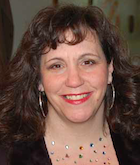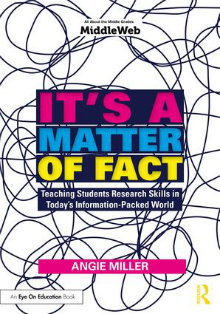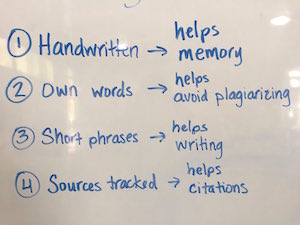Research Is a Core Skill in Our Info-Packed World
It’s a Matter of Fact: Teaching Students Research Skills in Today’s Information-Packed World
By Angie Miller
(Routledge/Eye On Education, 2018 – Learn more)
 Reviewed by Rita Platt
Reviewed by Rita Platt
In the age of alternate facts, “fake news,” and the dismissal of science, teaching students to conduct research is a critical skill. Angie Miller, author of the marvelous It’s a Matter of Fact: Teaching Students Research Skills in Today’s Information-Packed World, boldly states, “Research is an act of citizenship” (p. 21). I agree.
Today’s students have more information at their fingertips than ever before but continue to need their teachers to help them learn to sift through it and come to evidence-supported conclusions.
 Miller’s book is a comprehensive toolbox for teachers who realize that “well-developed research skills are important for the future of our county and integral for any democratic society to thrive” (p. 5).
Miller’s book is a comprehensive toolbox for teachers who realize that “well-developed research skills are important for the future of our county and integral for any democratic society to thrive” (p. 5).
The book is 130 pages, but don’t let the brevity fool you. Miller, a former New Hampshire Teacher of the Year, packs it from cover to cover with ideas, strategies, and recommendations to lead your students to successful research outcomes.
The book contains an introduction and eight chapters. Each chapter begins with an anecdote or example from Miller’s teaching experience. These anecdotes set the tone for the information to come and even inspire confidence. I truly love reading books by and learning from leaders, like Miller, who continue to teach. Her stories helped me feel connected to her in a way that inspired deep learning. If you teach English language arts, are a librarian, or a content-area teacher, I highly recommend you read this book.
After the introduction to the chapter, the author offers detailed information about the whats, whys, and hows of the topic. Throughout she calls attention to eResources, all of which are available through the publisher’s site. At the end of each chapter there are two helpful sections, “tldnr” (too long, did not read), which offers a summary of the preceding information, and #tryonething, which calls on readers to practice one or more aspects of the information discussed in the chapter. (Look below for summary of each of the chapters.)
What Are We Asking Students to Do?
Chapter One calls for teachers to really think about the research assignments they ask students to engage in, asking us to shift from passive to active work. Effective research assignments call for students to make choices about what they seek to learn, to creatively think about the topics they study, and to focus on what we want students to understand rather than what we went them to know. On page 19, a helpful chart illustrates the shift.
Miller suggests that instead of asking students, “How do antibiotics work?” we should try asking, “Are we overusing antibiotics?” Or, instead of asking students to do a simple biographical report about a given person, to ask, “How did the person you are researching make an impact on today’s world?” and further, how can this person’s life be connected to an issue facing society today?
I Don’t Have Time to Teach Research
Chapter Two makes the argument that teachers can and should balance content and skills teaching and that research should be integrated across the curriculum. Here Miller shares her guiding beliefs about teaching research. They are (p. 27):
Research:
- helps students make meaning of their world;
- is an act of citizenship;
- skills must be explicitly taught in every subject;
- becomes a habit when done frequently, and
- is an act of creation.
She believes that all teachers should “incorporate shorter more focused research projects…[so that] students can master the skills for larger projects” (p. 27). She offers ideas, planning templates, and forms to help teachers confer with students. Also included is a helpful reflection sheet for students to use to gauge their own work ethic and set goals for daily accomplishments (p. 33).
Finding Focus
Chapter Three is mostly about helping students to generate questions about a given topic and to narrow their ideas about how to study. She calls this “presearch” and convinced me that it is critical to success. She shares the five steps in presearch (p. 42):
- The teacher gathers resources related to the topic of study.
- Call for silence so students can think.
- Allow students at least one class period for exploration.
- Remind yourself to step back and give students time.
- Mingle with students, asking them focus questions to help them refine the central questions of their research.
Then Miller introduces the concept of “brainswarming,” which is a mix of traditional brainstorming with crowdsourcing. In brainswarming, students generate ideas which are “collected and shared out to the larger groups and then expanded upon” through discussion (p. 43). She offers several fun brainswarming activities. Last, this chapter helps teachers think about essential questions they can offer students to guide content-based research.
So Much Out There
Chapter Four shares strategies for managing sources. Miller starts with a call for librarians and classroom teachers to work together to serve student needs, a message that very much resonates with my librarian heart. She also shares internet search strategies such as using boolean terms, consulting data bases, moving beyond Google, and checking for the accuracy of online information.
Google has been my best buddy for a long, long time, and Miller helped me to think about reaching out and making friends with other search tools.
Take Note
Chapter Five, as implied, is about helping students learn to take notes. Miller starts with a discussion of what she calls, “the P-word,” plagiarism. She shares her “non-negotiables” for note-taking (p. 87):
- handwritten.
- In your own words.
- written in phrases, not complete sentences.
- tracked to each source.
This chapter also shares several summaries of good note taking strategies from oldies-but-goodies such as Cornell Notes and notecards to newer ideas including using color-coded sticky notes and poster-sized notes.
No matter how students record information, Miller rightly reminds us that though it might be “very easy to sit down and catch up on email” (p. 94) while students are taking notes, this is actually a critical time to be circulating among students to help them stay focused and troubleshoot.
Putting It All Together
Chapter Six asks teachers to think about how they help students organize their research before and during writing about it. Miller says, “We have to show them that organizing information is the most important groundwork they can lay for their writing” (p. 101).
She shares how she works with students through a series of narrations that explore how to categorize information from notes, how to write a thesis statement, “a fancy way of saying Main Idea of your Research” (p. 103), and how to write an introduction and conclusion. In each case Miller advises that a best practice is to model for students, composing paragraphs for and with them.
The Part That’s Never ExCITEing
Chapter seven is short and focuses on how to do various types of citing of sources. Although Miller approaches the topic as if it is a dreaded reality for writers, she knows it is critical and implores teachers to make that clear to students and to teach them how to cite correctly in the text and in works cited lists.
Beyond the Essay
Chapter eight encourages teachers to think beyond the research paper. In many ways it wraps back to the beginning of the book, when Miller calls for more frequent short research activities to be integrated into the school day. She says, “Essays are necessary undertakings that help our students fluently build, develop, and expand on their ideas…a critical academic skill…but in the real world, not every research process ends in a full-blown essay” (p. 126).
As such, she offers alternatives to long-form essays that still call on students to conduct research and share their findings. Ideas included are podcasts, public service announcements, websites, debates, letters to the editor, TED-syle talks, and infographics. (Read more about these at this Miller article.)
I Learned a Lot
Certainly it’s clear from my discussion of It’s a Matter of Fact: Teaching Students Research Skills in Today’s Information-Packed World that I both really enjoyed it and learned a great deal from each chapter. I have been teaching research skills to students for more than 24 years and still enjoy it! I am thrilled to have read Miller’s book and look forward to trying some of the tips and hints she shared.
Rita Platt (@ritaplatt) is a National Board Certified teacher with master’s degrees in reading, library, and leadership. Her experience includes teaching learners in remote Alaskan villages, inner cities, and rural communities. She currently is a teacher-librarian, teaches graduate courses for the Professional Development Institute, writes for We Teach We Learn, and blogs for MiddleWeb at Heart of the School.



































School librarians have a great deal of expertise and experience and can support you and your students in achieving success with research and inquiry learning activities. Yes! to monitoring students as they “make” notes. (I prefer the term “notemaking” because it encapsulates the “non-negotiables” listed above.) With two educators, you and your school librarian, coteaching and comonitoring students’ notemaking and other aspects of the research/inquiry process, more students will receive the individualized attention they need to succeed.
Oops… *you* (in the comment above) = classroom teachers and specialists who are reading this blog post (not Rita Platt)! Thank you for sharing, Rita.